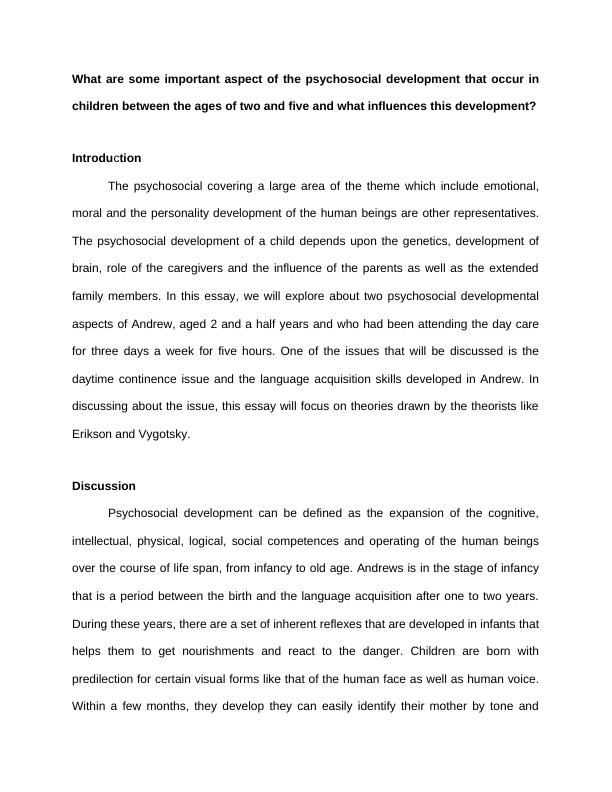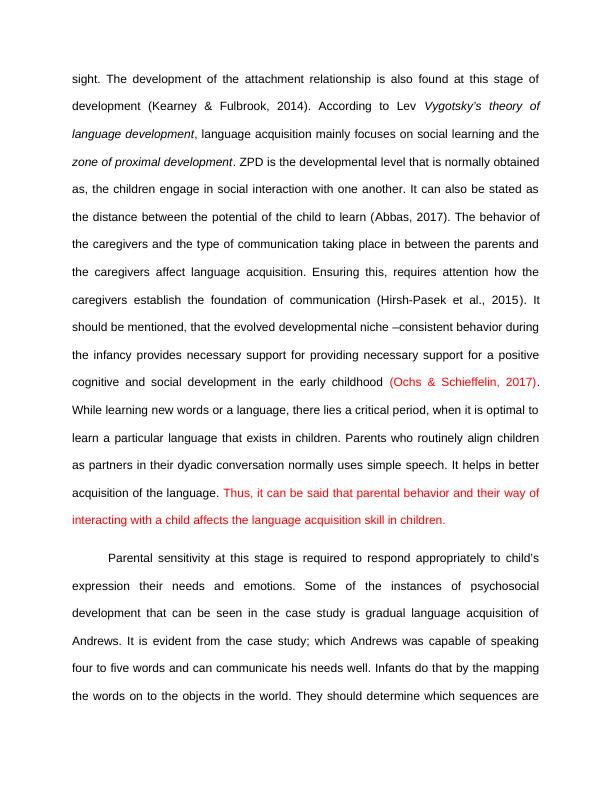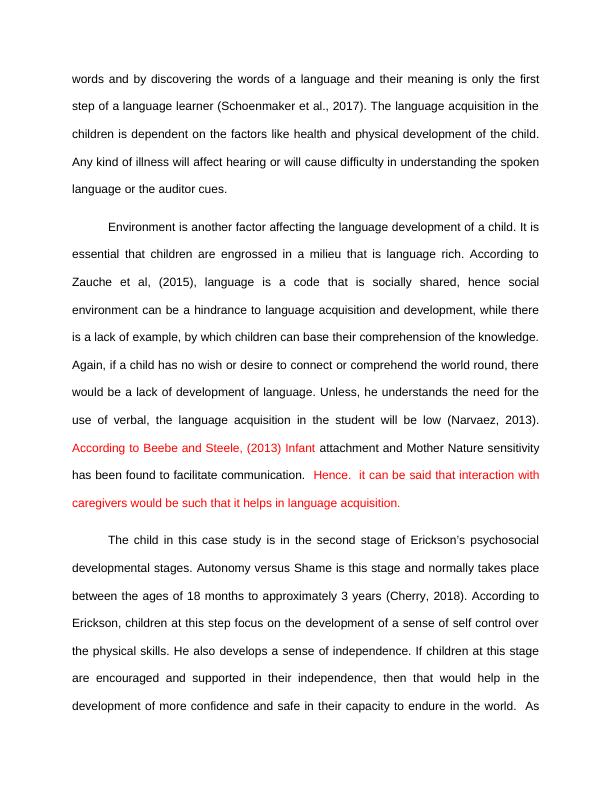Psychosocial Covering Essay 2022
Added on 2022-10-15
8 Pages2162 Words19 Views
What are some important aspect of the psychosocial development that occur in
children between the ages of two and five and what influences this development?
Introduction
The psychosocial covering a large area of the theme which include emotional,
moral and the personality development of the human beings are other representatives.
The psychosocial development of a child depends upon the genetics, development of
brain, role of the caregivers and the influence of the parents as well as the extended
family members. In this essay, we will explore about two psychosocial developmental
aspects of Andrew, aged 2 and a half years and who had been attending the day care
for three days a week for five hours. One of the issues that will be discussed is the
daytime continence issue and the language acquisition skills developed in Andrew. In
discussing about the issue, this essay will focus on theories drawn by the theorists like
Erikson and Vygotsky.
Discussion
Psychosocial development can be defined as the expansion of the cognitive,
intellectual, physical, logical, social competences and operating of the human beings
over the course of life span, from infancy to old age. Andrews is in the stage of infancy
that is a period between the birth and the language acquisition after one to two years.
During these years, there are a set of inherent reflexes that are developed in infants that
helps them to get nourishments and react to the danger. Children are born with
predilection for certain visual forms like that of the human face as well as human voice.
Within a few months, they develop they can easily identify their mother by tone and
children between the ages of two and five and what influences this development?
Introduction
The psychosocial covering a large area of the theme which include emotional,
moral and the personality development of the human beings are other representatives.
The psychosocial development of a child depends upon the genetics, development of
brain, role of the caregivers and the influence of the parents as well as the extended
family members. In this essay, we will explore about two psychosocial developmental
aspects of Andrew, aged 2 and a half years and who had been attending the day care
for three days a week for five hours. One of the issues that will be discussed is the
daytime continence issue and the language acquisition skills developed in Andrew. In
discussing about the issue, this essay will focus on theories drawn by the theorists like
Erikson and Vygotsky.
Discussion
Psychosocial development can be defined as the expansion of the cognitive,
intellectual, physical, logical, social competences and operating of the human beings
over the course of life span, from infancy to old age. Andrews is in the stage of infancy
that is a period between the birth and the language acquisition after one to two years.
During these years, there are a set of inherent reflexes that are developed in infants that
helps them to get nourishments and react to the danger. Children are born with
predilection for certain visual forms like that of the human face as well as human voice.
Within a few months, they develop they can easily identify their mother by tone and

sight. The development of the attachment relationship is also found at this stage of
development (Kearney & Fulbrook, 2014). According to Lev Vygotsky’s theory of
language development, language acquisition mainly focuses on social learning and the
zone of proximal development. ZPD is the developmental level that is normally obtained
as, the children engage in social interaction with one another. It can also be stated as
the distance between the potential of the child to learn (Abbas, 2017). The behavior of
the caregivers and the type of communication taking place in between the parents and
the caregivers affect language acquisition. Ensuring this, requires attention how the
caregivers establish the foundation of communication (Hirsh-Pasek et al., 2015). It
should be mentioned, that the evolved developmental niche –consistent behavior during
the infancy provides necessary support for providing necessary support for a positive
cognitive and social development in the early childhood (Ochs & Schieffelin, 2017).
While learning new words or a language, there lies a critical period, when it is optimal to
learn a particular language that exists in children. Parents who routinely align children
as partners in their dyadic conversation normally uses simple speech. It helps in better
acquisition of the language. Thus, it can be said that parental behavior and their way of
interacting with a child affects the language acquisition skill in children.
Parental sensitivity at this stage is required to respond appropriately to child’s
expression their needs and emotions. Some of the instances of psychosocial
development that can be seen in the case study is gradual language acquisition of
Andrews. It is evident from the case study; which Andrews was capable of speaking
four to five words and can communicate his needs well. Infants do that by the mapping
the words on to the objects in the world. They should determine which sequences are
development (Kearney & Fulbrook, 2014). According to Lev Vygotsky’s theory of
language development, language acquisition mainly focuses on social learning and the
zone of proximal development. ZPD is the developmental level that is normally obtained
as, the children engage in social interaction with one another. It can also be stated as
the distance between the potential of the child to learn (Abbas, 2017). The behavior of
the caregivers and the type of communication taking place in between the parents and
the caregivers affect language acquisition. Ensuring this, requires attention how the
caregivers establish the foundation of communication (Hirsh-Pasek et al., 2015). It
should be mentioned, that the evolved developmental niche –consistent behavior during
the infancy provides necessary support for providing necessary support for a positive
cognitive and social development in the early childhood (Ochs & Schieffelin, 2017).
While learning new words or a language, there lies a critical period, when it is optimal to
learn a particular language that exists in children. Parents who routinely align children
as partners in their dyadic conversation normally uses simple speech. It helps in better
acquisition of the language. Thus, it can be said that parental behavior and their way of
interacting with a child affects the language acquisition skill in children.
Parental sensitivity at this stage is required to respond appropriately to child’s
expression their needs and emotions. Some of the instances of psychosocial
development that can be seen in the case study is gradual language acquisition of
Andrews. It is evident from the case study; which Andrews was capable of speaking
four to five words and can communicate his needs well. Infants do that by the mapping
the words on to the objects in the world. They should determine which sequences are

words and by discovering the words of a language and their meaning is only the first
step of a language learner (Schoenmaker et al., 2017). The language acquisition in the
children is dependent on the factors like health and physical development of the child.
Any kind of illness will affect hearing or will cause difficulty in understanding the spoken
language or the auditor cues.
Environment is another factor affecting the language development of a child. It is
essential that children are engrossed in a milieu that is language rich. According to
Zauche et al, (2015), language is a code that is socially shared, hence social
environment can be a hindrance to language acquisition and development, while there
is a lack of example, by which children can base their comprehension of the knowledge.
Again, if a child has no wish or desire to connect or comprehend the world round, there
would be a lack of development of language. Unless, he understands the need for the
use of verbal, the language acquisition in the student will be low (Narvaez, 2013).
According to Beebe and Steele, (2013) Infant attachment and Mother Nature sensitivity
has been found to facilitate communication. Hence. it can be said that interaction with
caregivers would be such that it helps in language acquisition.
The child in this case study is in the second stage of Erickson’s psychosocial
developmental stages. Autonomy versus Shame is this stage and normally takes place
between the ages of 18 months to approximately 3 years (Cherry, 2018). According to
Erickson, children at this step focus on the development of a sense of self control over
the physical skills. He also develops a sense of independence. If children at this stage
are encouraged and supported in their independence, then that would help in the
development of more confidence and safe in their capacity to endure in the world. As
step of a language learner (Schoenmaker et al., 2017). The language acquisition in the
children is dependent on the factors like health and physical development of the child.
Any kind of illness will affect hearing or will cause difficulty in understanding the spoken
language or the auditor cues.
Environment is another factor affecting the language development of a child. It is
essential that children are engrossed in a milieu that is language rich. According to
Zauche et al, (2015), language is a code that is socially shared, hence social
environment can be a hindrance to language acquisition and development, while there
is a lack of example, by which children can base their comprehension of the knowledge.
Again, if a child has no wish or desire to connect or comprehend the world round, there
would be a lack of development of language. Unless, he understands the need for the
use of verbal, the language acquisition in the student will be low (Narvaez, 2013).
According to Beebe and Steele, (2013) Infant attachment and Mother Nature sensitivity
has been found to facilitate communication. Hence. it can be said that interaction with
caregivers would be such that it helps in language acquisition.
The child in this case study is in the second stage of Erickson’s psychosocial
developmental stages. Autonomy versus Shame is this stage and normally takes place
between the ages of 18 months to approximately 3 years (Cherry, 2018). According to
Erickson, children at this step focus on the development of a sense of self control over
the physical skills. He also develops a sense of independence. If children at this stage
are encouraged and supported in their independence, then that would help in the
development of more confidence and safe in their capacity to endure in the world. As

End of preview
Want to access all the pages? Upload your documents or become a member.
Related Documents
Human Development Case Study 2022lg...
|7
|2181
|18
Development of psychosocial skills in childrenlg...
|6
|1727
|80
Human Relations Essay 2022lg...
|7
|1547
|33
Psychosocial Development of a Child between Two to Five Yearslg...
|10
|1785
|302
Freud’s Psychosexual Stages and Erikson’s Psychosocial Stageslg...
|4
|562
|219
Psychosocial Development in Children: Normative Components and Influencing Factorslg...
|7
|1605
|136
